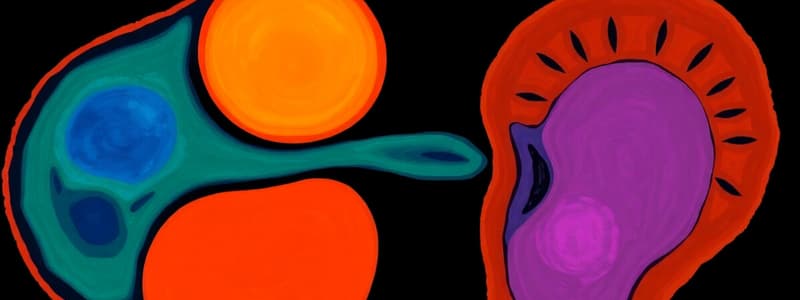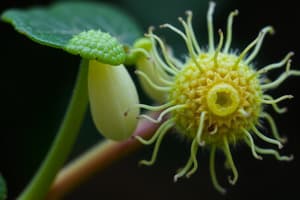Podcast
Questions and Answers
Which of the following scenarios best illustrates a study within the realm of community ecology?
Which of the following scenarios best illustrates a study within the realm of community ecology?
- Assessing the impact of climate change on the melting of glaciers.
- Investigating the competitive interactions between two species of rodents inhabiting the same desert ecosystem. (correct)
- Examining the genetic diversity within a population of endangered primates.
- Analyzing the rate of carbon cycling between a forest and the atmosphere.
A remote island ecosystem experiences a drastic reduction in its native plant species due to the introduction of an invasive plant. Which of the following is the most likely consequence regarding biodiversity and ecosystem services?
A remote island ecosystem experiences a drastic reduction in its native plant species due to the introduction of an invasive plant. Which of the following is the most likely consequence regarding biodiversity and ecosystem services?
- An increase in the island's overall biodiversity as the new plant diversifies the flora.
- Improved nutrient cycling as the invasive plant decomposes at a faster rate.
- A decline in pollination services due to the displacement of native flowering plants that support local pollinators. (correct)
- Enhanced stability in the island's climate regulation due to the new plant's efficient carbon sequestration.
A large area of rainforest is cleared for cattle ranching. What are the most likely environmental consequences of this deforestation?
A large area of rainforest is cleared for cattle ranching. What are the most likely environmental consequences of this deforestation?
- Reduced soil erosion and a stabilization of regional weather patterns.
- Increased carbon sequestration and a decrease in local biodiversity.
- Decreased water pollution due to the reduced use of chemical fertilizers.
- Increased habitat loss, contributing to a decline in biodiversity and increased greenhouse gas emissions. (correct)
A conservation organization is deciding between in situ and ex situ conservation strategies for an endangered amphibian species. Which factor would most strongly favor an in situ conservation approach?
A conservation organization is deciding between in situ and ex situ conservation strategies for an endangered amphibian species. Which factor would most strongly favor an in situ conservation approach?
A city implements stricter regulations on industrial emissions, invests in public transportation, and promotes renewable energy sources. Which environmental issue are these strategies primarily designed to address?
A city implements stricter regulations on industrial emissions, invests in public transportation, and promotes renewable energy sources. Which environmental issue are these strategies primarily designed to address?
Which of the following accurately describes the relationship between gametogenesis and fertilization?
Which of the following accurately describes the relationship between gametogenesis and fertilization?
A botanist discovers a new plant species that can reproduce both through self-pollination and cross-pollination. In terms of genetic diversity, what is the most likely outcome?
A botanist discovers a new plant species that can reproduce both through self-pollination and cross-pollination. In terms of genetic diversity, what is the most likely outcome?
During human reproduction, where does fertilization typically occur, and what is the immediate result of this process?
During human reproduction, where does fertilization typically occur, and what is the immediate result of this process?
Which of the following events is unique to sexual reproduction and contributes most significantly to genetic variation in offspring?
Which of the following events is unique to sexual reproduction and contributes most significantly to genetic variation in offspring?
A researcher is studying a plant species that exhibits double fertilization. What are the two key outcomes of this process in the plant's reproductive cycle?
A researcher is studying a plant species that exhibits double fertilization. What are the two key outcomes of this process in the plant's reproductive cycle?
What is the main distinction between spermatogenesis and oogenesis in humans regarding the number of functional gametes produced?
What is the main distinction between spermatogenesis and oogenesis in humans regarding the number of functional gametes produced?
Which of the following is the correct sequence of events in sexual reproduction?
Which of the following is the correct sequence of events in sexual reproduction?
How does asexual reproduction differ fundamentally from sexual reproduction in terms of genetic diversity?
How does asexual reproduction differ fundamentally from sexual reproduction in terms of genetic diversity?
Which of the following best illustrates the law of independent assortment?
Which of the following best illustrates the law of independent assortment?
A couple, both carriers for cystic fibrosis (an autosomal recessive disorder), are planning to have a child. What is the probability that their child will have cystic fibrosis?
A couple, both carriers for cystic fibrosis (an autosomal recessive disorder), are planning to have a child. What is the probability that their child will have cystic fibrosis?
Which of the following is NOT a component of innate immunity?
Which of the following is NOT a component of innate immunity?
How do vaccines provide immunity?
How do vaccines provide immunity?
Which of the following is a key difference between DNA and RNA?
Which of the following is a key difference between DNA and RNA?
During DNA replication, which enzyme is responsible for adding complementary nucleotides to the template strand?
During DNA replication, which enzyme is responsible for adding complementary nucleotides to the template strand?
A population of butterflies exhibits two distinct color patterns: blue and orange. Over time, the intermediate green color becomes less common. What type of natural selection is likely occurring?
A population of butterflies exhibits two distinct color patterns: blue and orange. Over time, the intermediate green color becomes less common. What type of natural selection is likely occurring?
Which of the following mechanisms of evolution introduces new genetic variation into a population?
Which of the following mechanisms of evolution introduces new genetic variation into a population?
Which of the following correctly describes the role of restriction enzymes in recombinant DNA technology?
Which of the following correctly describes the role of restriction enzymes in recombinant DNA technology?
What is the primary purpose of bioprocess engineering in biotechnology?
What is the primary purpose of bioprocess engineering in biotechnology?
Which of the following best describes the function of DNA ligase?
Which of the following best describes the function of DNA ligase?
A researcher is studying a population of fish in a pond. They observe that the population size has remained relatively constant over the past few years. What can they infer about the birth and death rates in this population?
A researcher is studying a population of fish in a pond. They observe that the population size has remained relatively constant over the past few years. What can they infer about the birth and death rates in this population?
Which of the following describes the use of microbes in sewage treatment?
Which of the following describes the use of microbes in sewage treatment?
The Hardy-Weinberg principle describes conditions for genetic equilibrium. Which scenario would most likely disrupt this equilibrium in a small, isolated population?
The Hardy-Weinberg principle describes conditions for genetic equilibrium. Which scenario would most likely disrupt this equilibrium in a small, isolated population?
Why is understanding reproductive health important beyond just preventing pregnancy?
Why is understanding reproductive health important beyond just preventing pregnancy?
Flashcards
Asexual Reproduction
Asexual Reproduction
Offspring arise from a single parent, creating genetically identical copies.
Sexual Reproduction
Sexual Reproduction
Fusion of male and female gametes, introducing genetic variation.
Gametogenesis
Gametogenesis
Formation of male and female gametes.
Pollination
Pollination
Signup and view all the flashcards
Double Fertilization
Double Fertilization
Signup and view all the flashcards
Stamen
Stamen
Signup and view all the flashcards
Pistil
Pistil
Signup and view all the flashcards
Implantation
Implantation
Signup and view all the flashcards
Community Ecology
Community Ecology
Signup and view all the flashcards
Biodiversity
Biodiversity
Signup and view all the flashcards
Ecosystem Services
Ecosystem Services
Signup and view all the flashcards
In Situ Conservation
In Situ Conservation
Signup and view all the flashcards
Deforestation
Deforestation
Signup and view all the flashcards
Genetics
Genetics
Signup and view all the flashcards
Law of Segregation
Law of Segregation
Signup and view all the flashcards
Law of Dominance
Law of Dominance
Signup and view all the flashcards
Law of Independent Assortment
Law of Independent Assortment
Signup and view all the flashcards
Evolution
Evolution
Signup and view all the flashcards
Natural Selection
Natural Selection
Signup and view all the flashcards
Hardy-Weinberg Principle
Hardy-Weinberg Principle
Signup and view all the flashcards
Speciation
Speciation
Signup and view all the flashcards
Immunity
Immunity
Signup and view all the flashcards
Innate Immunity
Innate Immunity
Signup and view all the flashcards
Acquired Immunity
Acquired Immunity
Signup and view all the flashcards
Cancer
Cancer
Signup and view all the flashcards
Biotechnology
Biotechnology
Signup and view all the flashcards
Genetic Engineering
Genetic Engineering
Signup and view all the flashcards
Ecology
Ecology
Signup and view all the flashcards
Study Notes
- Biology MCQs for Class 12 cover a wide range of topics in the field of biology
- Multiple-choice questions are designed to test understanding, application, and analysis of concepts
- They're structured to assess recall, comprehension, and problem-solving skills
- Topics usually correlate with the Class 12 biology syllabus
Reproduction
- Reproduction in organisms includes asexual and sexual reproduction
- Asexual reproduction involves a single parent, resulting in offspring genetically identical to the parent
- Forms of asexual reproduction: binary fission, budding, fragmentation, and spore formation
- Sexual reproduction involves the fusion of gametes from two parents, leading to genetic variation
- Sexual reproduction phases: pre-fertilization, fertilization, and post-fertilization events
- Pre-fertilization events involve gametogenesis (formation of gametes) and gamete transfer
- Fertilization, or syngamy, is the fusion of male and female gametes to form a zygote
- Post-fertilization events include the development of the zygote into an embryo (embryogenesis)
- In flowering plants, the reproductive parts are located in the flower
- The stamen is the male reproductive part, consisting of the anther and filament
- The pistil is the female reproductive part, consisting of the stigma, style, and ovary
- Pollination is the transfer of pollen grains from the anther to the stigma
- Pollination can be self-pollination (autogamy) or cross-pollination (allogamy)
- Fertilization in plants involves the fusion of a male gamete with the egg cell to form a zygote, and another male gamete with the polar nuclei to form the endosperm (double fertilization)
- Embryo development leads to the formation of a seed, and the ovary develops into a fruit
- Human reproduction involves sexual reproduction
- The male reproductive system consists of testes, vas deferens, seminal vesicles, prostate gland, and penis
- The female reproductive system consists of ovaries, fallopian tubes, uterus, cervix, and vagina
- Gametogenesis in males is called spermatogenesis and occurs in the testes
- Gametogenesis in females is called oogenesis and occurs in the ovaries
- The menstrual cycle involves cyclical changes in the female reproductive system
- Fertilization in humans occurs in the fallopian tube
- Implantation is the attachment of the blastocyst to the uterine wall
- Pregnancy involves the development of the embryo and fetus in the uterus
- Parturition is the process of childbirth
- Reproductive health includes physical, mental, and social well-being related to reproduction
- Birth control methods include natural methods, barrier methods, IUDs, oral contraceptives, and surgical methods
- Sexually transmitted infections (STIs) are infections transmitted through sexual contact
Genetics and Evolution
- Genetics is the study of heredity and variation
- Mendel's laws of inheritance include the law of dominance, law of segregation, and law of independent assortment
- The law of dominance states that in a heterozygous condition, the dominant allele masks the expression of the recessive allele
- The law of segregation states that alleles separate during gamete formation
- The law of independent assortment states that alleles of different genes assort independently during gamete formation
- Chromosomal theory of inheritance links Mendelian factors (genes) to chromosomes
- Linkage and crossing over affect the inheritance of genes located on the same chromosome
- Sex determination in humans is determined by the presence or absence of the Y chromosome
- Genetic disorders can be Mendelian disorders (e.g., hemophilia, cystic fibrosis) or chromosomal disorders (e.g., Down syndrome, Turner syndrome)
- DNA is the genetic material, consisting of nucleotides
- DNA structure is a double helix, with complementary base pairing (A with T, and G with C)
- RNA is also a nucleic acid, single-stranded, and contains uracil (U) instead of thymine (T)
- DNA replication is the process of making identical copies of DNA
- Transcription is the process of synthesizing RNA from a DNA template
- Translation is the process of synthesizing proteins from mRNA
- Evolution is the change in the heritable characteristics of biological populations over successive generations
- Darwin's theory of natural selection explains how species evolve over time
- Natural selection is the process by which organisms with favorable traits are more likely to survive and reproduce
- Evidence for evolution includes fossil evidence, anatomical evidence, embryological evidence, and molecular evidence
- Mechanisms of evolution include mutation, gene flow, genetic drift, and natural selection
- Hardy-Weinberg principle describes the conditions under which allele frequencies in a population remain constant
- Types of natural selection include stabilizing selection, directional selection, and disruptive selection
- Speciation is the process by which new species arise
Biology and Human Welfare
- Diseases can be caused by pathogens such as bacteria, viruses, fungi, and parasites
- Common human diseases include typhoid, pneumonia, common cold, malaria, AIDS, and cancer
- Immunity is the ability of the body to resist diseases
- Innate immunity is present from birth and includes physical barriers, physiological barriers, cellular barriers, and cytokine barriers
- Acquired immunity develops after exposure to a pathogen and includes humoral immunity (B cells) and cell-mediated immunity (T cells)
- Vaccines provide artificial active immunity by exposing the body to weakened or inactive pathogens
- Cancer is a disease characterized by uncontrolled cell growth
- Causes of cancer include genetic mutations, exposure to carcinogens, and viral infections
- AIDS (acquired immunodeficiency syndrome) is caused by the human immunodeficiency virus (HIV)
- HIV weakens the immune system, making individuals susceptible to opportunistic infections
- Microbes in human welfare include their use in household products, industrial products, sewage treatment, energy generation, and biocontrol agents
- Microbes are used in the production of various food products such as curd, cheese, and bread
- Antibiotics are chemicals produced by microbes that can kill or inhibit the growth of other microbes
- Sewage treatment involves the use of microbes to break down organic matter in wastewater
- Biogas is a mixture of gases produced by the microbial breakdown of organic matter in the absence of oxygen
- Biocontrol agents are organisms used to control pests and diseases
- Biofertilizers are organisms that enrich the nutrient quality of the soil
Biotechnology
- Biotechnology is the use of living organisms or their products to develop or modify products for specific purposes
- Principles of biotechnology include genetic engineering and bioprocess engineering
- Genetic engineering involves altering the genetic material of an organism to create new characteristics
- Bioprocess engineering involves maintaining sterile conditions to enable the growth of desired microbes for the manufacture of biotechnological products
- Recombinant DNA technology involves the use of enzymes to cut and paste DNA fragments, creating recombinant DNA molecules
- Tools of recombinant DNA technology include enzymes (restriction enzymes, DNA ligase), vectors (plasmids, bacteriophages), and host organisms
- Restriction enzymes cut DNA at specific sequences, creating fragments with sticky ends or blunt ends
- Vectors are used to carry foreign DNA into a host cell
- Host organisms are used to replicate the recombinant DNA and produce the desired product
- Applications of biotechnology include agriculture, medicine, and industry
- In agriculture, biotechnology is used to develop genetically modified (GM) crops that are resistant to pests, diseases, and environmental stress
- In medicine, biotechnology is used to produce drugs, vaccines, and diagnostic tools
- In industry, biotechnology is used to produce enzymes, biofuels, and bioplastics
- Ethical issues related to biotechnology include concerns about the safety of GM crops, the use of genetic engineering in humans, and biopiracy
Ecology
- Ecology is the study of the interactions between organisms and their environment
- Organisms and environment includes biotic (living) and abiotic (non-living) components
- Population ecology studies the dynamics of populations, including population size, density, distribution, and growth
- Community ecology studies the interactions between different species in a community
- Ecosystem ecology studies the flow of energy and cycling of nutrients in ecosystems
- Biodiversity and Conservation includes the variety of life on Earth, at all its levels, from genes to ecosystems
- Biodiversity is essential for ecosystem functioning, providing ecosystem services such as pollination, nutrient cycling, and climate regulation
- Threats to biodiversity include habitat loss, overexploitation, invasive species, pollution, and climate change
- Conservation strategies include in situ conservation (protecting species in their natural habitats) and ex situ conservation (protecting species outside their natural habitats)
- Environmental issues include pollution, deforestation, climate change, and loss of biodiversity
- Air pollution is caused by the release of pollutants into the atmosphere
- Water pollution is caused by the release of pollutants into bodies of water
- Soil pollution is caused by the accumulation of pollutants in the soil
- Deforestation is the clearing of forests for other land uses
- Climate change is caused by the increase in greenhouse gases in the atmosphere, leading to global warming and changes in weather patterns
- Strategies for addressing environmental issues include reducing pollution, conserving resources, and promoting sustainable development
Studying That Suits You
Use AI to generate personalized quizzes and flashcards to suit your learning preferences.




